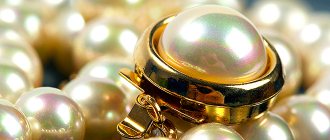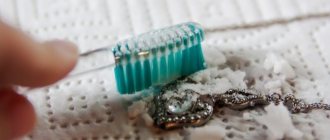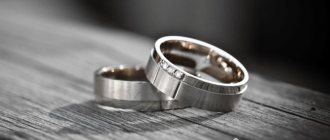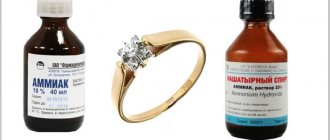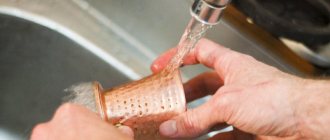Kitchen utensils made of stainless steel look stylish, they are easy to use and have a long service life, but such products are susceptible to various types of contamination: carbon deposits, plaque, soot, and corrosion. This raises a reasonable question: how to clean stainless steel at home quickly and effectively?
Stainless steel is used to produce beautiful and functional cookware. To preserve the external and operational properties of the products, and prevent the pots from darkening, provide them with proper care.
Available folk remedies or household chemicals will help you wash steel and restore its shine and shine. In this article we have collected useful tips and effective methods for cleaning stainless steel.
Causes of pollution
Stainless steel is resistant to environmental influences, which is due to the chromium content in the material. This element creates a protective layer that protects the surface from corrosion, rust, and blackness.
However, improper maintenance results in significant accumulation of dust, dirt and grease. They destroy the protective properties, make stainless steel vulnerable and reduce its wear resistance. Rust, soot, and deposits appear on the surface, and the characteristic metallic sheen of the material disappears. As a result of such contamination, the device or item becomes unsuitable for further use.
As a result of use, stainless steel appliances and utensils darken and become covered with plaque and grease. You can correct the situation at home using improvised means.
How to clean stainless steel
Stainless steel household products are often found in modern kitchens: cutlery (spoons, forks, knives, pots), kitchen sink and stove
The question of their safety is relevant, and therefore we will pay close attention to methods of care and cleaning from oxides and stains
Traditional methods
Household products include:
- Baking soda;
- Activated carbon;
- Table vinegar;
- Citric acid or juice.
Apply dry substances by applying to areas with stains and leaving for 1-2 hours for soda, 15-20 minutes for activated carbon. When applied, the coal powder is moistened with a small amount of water, a reaction begins, and a slurry is formed. After treatment, items are wiped with a soft sponge and washed under running warm water.
Vinegar and citric acid are universal means that help cope with stains that appear on the surface of stainless steel. To process, take a clean flannel cloth, soak it in a little vinegar or lemon juice and rub the tarnished areas of the dishes. Upon completion of the procedure, rinse these areas with clean water and wipe dry.
Purchased chemicals
The range includes household chemicals that allow you to effectively deal with darkening and stains on the surface of stainless metal. When choosing, give preference to less aggressive chemicals to minimize harm from exposure.
The most common compositions include imported products from the brands “Amway”, “Magic Power”, “Dr. Beckmann” and others. Before use, heat the dishes to a certain temperature, apply the liquid composition and leave for the time specified in the instructions. Rinse off the product with a sponge under running water and wipe the stainless steel cookware dry.
INFORMATION!
The main advantage of household chemicals is saving time (traces of stains are removed quickly and for a long time). The disadvantage is the high cost of imported products.
Video recommendations
HOW TO CLEAN A POT, frying pan and other utensils from carbon deposits and grease EASILY? How to wash everything until it shines?
Watch this video on YouTube
General cleaning recommendations
Stainless steel cookware should be cleaned as often as possible to avoid darkening of the metal, the appearance of persistent greasy stains or carbon deposits. For cleaning, use available home remedies or special household chemicals.
Steel objects should be washed with foam sponges, washcloths, and soft brushes . Metal scrapers and other abrasive tools leave unsightly scratches, so use them only as a last resort.
To clean stainless steel, do not use abrasives or hard brushes. They damage the protective layer, leave scratches, and spoil the aesthetic appearance of products.
Before cleaning, sort all items according to two characteristics: by purpose (pots, pans, cutlery) and by type of contamination (grease, carbon deposits on the outside, dust, etc.). This will allow you to choose the most suitable cleaning method, saving time and effort.
How to polish stainless steel to a mirror at home
Polishing stainless steel in a private workshop to a mirror finish is considered affordable. The processing time depends on the number of scratches on the surface, as well as the presence of metal oxidation. Chemical polishing is not recommended as it may be harmful to humans. To process your product with your own hands until it shines you need:
- Install a polishing wheel with fine abrasive on the grinding machine.
- Choose a polish for stainless steel without wax; it is recommended to use abrasive grains of a minimum size in the composition.
- Pour polish onto the circle.
- Bring the device to the left corner of the product.
- Apply power to the machine by pressing the start button.
- The device must be moved in a circular motion.
- After polishing, turn off the power, and then use a rag to remove the remaining polish by wiping away any roughness.
Compliance with stainless metal processing technology will help to obtain a surface without roughness up to class 14. At the same time, the metal acquires a mirror shine.
Polishing stainless steel, flat. Full version.
How to clean a stainless steel hood and sink
The following products and methods are suitable for cleaning a hood or kitchen sink:
- Use special medications. Before using household chemicals, read the instructions and follow the recommendations.
- Wash the surface with a solution made from lemon juice and water.
- Apply vinegar to a soft cloth and wipe all surfaces thoroughly. Wash the hood or sink with clean water and then wipe dry.
- Combine baking soda and mustard powder in equal proportions. Apply the mixture to the stainless steel with a sponge and rub well to remove dirt.
- Peel the potatoes, cut them in half and grate all surfaces. This method will return shine and shine to steel objects.
Household chemicals will help restore the cleanliness and shine of your stainless steel sink. When working with them, follow the instructions, and after cleaning, rinse the surface thoroughly
How to rub stainless steel to make it shine?
One of the easiest ways to remove stains on stainless steel from water drops and fingers is window cleaner. It is sprayed onto the surface and wiped with a dry soft cloth. Then they are washed, wiped again and additionally polished with a dry soft towel.
Interesting materials:
How to find out the date of registration in government services? How to find out date of birth in Apple ID? How to find out the debt from the judiciary? How to find out if there is deportation to Russia? How to find out if you have an electronic sick leave? How to find out if there is shim in the monitor? How do you know if there is a draft? How to find out if you have alimony? How to find out if the bailiffs have a debt? How to find out the IP address of a network folder?
Home remedies for cleaning stainless steel cutlery
The simplest product for cleaning stainless steel is dishwashing gel . Wash spoons and forks thoroughly using a soft foam sponge and the selected preparation. After cleaning, rinse the appliances under running water and wipe dry so that no white streaks remain.
A simple and effective method for cleaning cutlery is boiling. Place the products in a large container, fill with hot water and put on fire. Boil for 20-40 minutes, then rinse in clean water and wipe
Other cleaning methods:
- toothpaste or toothpaste to a cloth and rub it over all forks, spoons and knives. Rinse items under running water and dry on a towel.
- Prepare a liquid solution based on water and mustard powder . Soak a sponge in the liquid and treat all products.
- To get rid of dark tea stains, soak in vinegar and wipe the utensils. To remove stubborn stains, soak the items in a vinegar solution for 10-20 minutes.
- ash will help clean cutlery outdoors .
Store cleaned stainless steel cutlery in special compartments, away from moisture, dust and other sources of contamination.
Cleaning with improvised means
If you don’t have special products at home, you can make do with what’s at hand.
List of available tools:
- lemon acid;
- toothpaste;
- hydrogen peroxide;
- Activated carbon;
- soda, salt, vinegar, etc.
Mustard powder gained recognition when modern detergents did not yet exist. Dissolve a couple of tablespoons of mustard powder in hot water and wash the dishes in this solution. Then rinse with clean water. Mustard is an excellent remedy for disinfecting dishes and giving them shine.
Vinegar and citric acid are also a good way to remove plaque. Use a swab dipped in acid to wipe the surface of the stainless steel device and rinse with clean water. The kettle or pots will shine like new.
At worst, toothpaste will do for cleaning metal things. After all, it contains fluorine, which prevents the formation of plaque.
Effective Ways to Clean Steel Pans
Stainless steel pans are susceptible to various stains, but burnt food and persistent greasy deposits are more common. Home remedies will help you wipe off stains quickly and easily.
Steel pans are in demand among housewives because they are easy to use and care for, and they look stylish and beautiful. To extend their service life, maintain shine and cleanliness, carry out preventive cleaning
Lemon juice
Lemon juice will help remove grease from the pan:
- In a container, mix 1 tbsp. l. juice and 1 glass of water.
- Dampen a soft sponge in the solution and treat all surfaces with it.
- Rinse away any remaining dirt with running water.
- Wipe the pan dry with a soft cloth. To add shine, polish it with a piece of flannel.
Coffee
Aromatic coffee will help get rid of burnt and greasy stains. Apply a small amount of ground coffee powder to a damp sponge and gently scrub the stained areas. After removing stains, rinse the pan with clean water and dry naturally.
After cleaning stainless steel kitchen utensils, wash them well with dishwashing detergent and then with clean water. This is guaranteed to get rid of plaque and return the surface clean and shiny.
Activated carbon
The following method will help you cope with the remains of burnt food:
- Fill the bottom of a still warm container with crushed activated carbon or table salt so that the product covers the dirt.
- Leave the pan for 30 minutes.
- Wash the container with a sponge using dishwashing detergent, and then rinse with a solution of lemon juice.
To make the pan shine and shine, after cleaning, wipe the surface with a cloth moistened with a solution of ammonia (1 drop per 1 liter of water). This method is applicable not only for dishes, but also for any stainless steel surfaces - hood, kettle, stove or sink.
Folk remedies for cleaning stainless steel
It is not necessary to use harsh chemicals to clean stainless steel; there are many ways to clean and polish stainless steel that our mothers and grandmothers used. Here are the most popular ones.
To clean contaminated steel surfaces, you can use hot water with the addition of mustard powder. Using a brush and the prepared solution, you can clean many types of dirt. After cleaning with mustard powder, all surfaces should be rinsed with clean water and wiped dry.
To remove white sediment from water from the surface of stainless steel, you can use acids. Vinegar or lemon are suitable for these purposes. You need to wipe steel items with a cloth soaked in vinegar or lemon juice and rinse with clean water.
If the dirt has dried, a paste of baking soda and a small amount of water will help you. Apply it to the stain and leave it for a while. After which the dirt can be easily washed off with a cleaning cloth.
Preventing contamination
To extend the life of stainless steel products, follow the rules for care and cleaning:
- Thoroughly clean off fat and food residues after each cooking;
- During cooking, make sure that the food does not burn to the bottom;
- do not use abrasive compounds or hard tools - they will leave scratches and damage the top protective layer;
- wipe dishes, utensils and surfaces after use to prevent oxidation and avoid streaks and deposits;
- Polish the metal periodically using baby oil or olive oil.
Before storing stainless steel cookware, dry it thoroughly with a soft towel. This will prevent the formation of white plaque and streaks.
Every housewife can clean stainless steel. To do this, take a little time and use the available tools that are available in every kitchen. In order to preserve the performance characteristics of stainless steel and the presentable appearance of the products for a long time, follow the rules of use and do not forget to clean them.
Polishing with chemicals
This method is most often used when you need to clean small items. The main thing is that polishing takes little time and is very simple to do. Below are several recipes for solutions.
Recipe 1
It is important to maintain proportions here. Contains: 230 ml sulfuric acid, 70 ml hydrochloric acid, and 40 ml nitric acid
The rest is water.
For one liter of solution you need another 5 g of sodium chloride, 5 g of acid black dye and 10 grams of wood glue.
The resulting liquid must be heated to 70 degrees Celsius and the part must be lowered there. The product can be left in the solution for a maximum of half an hour.
Recipe 2
You will need orthophosphoric acid, it should make up 20-30 percent of the total volume. Hydrochloric acid (3-4%), nitric acid (4-5%), methyl orange (1%). The rest is water. The solution should be at room temperature, and keep the product in it for no longer than 10 minutes.
Recipe 3
The acid content is indicated per liter of solution. Acid orange dye - 25 g, sulfuric acid - 230 g, hydrochloric acid - 660 g. Heat the liquid to seventy degrees and keep the metal in it for no more than three minutes.
Polishing rules are given below:
- The metal must be thoroughly cleaned before polishing. Next, place the product in the solution. It should be remembered that only distilled water can be used here.
- During the procedure, the solution must be constantly stirred, only in this case the chemical reaction will take place 100%.
- When the required time has passed, the part is removed and washed well with running water. After this, the product must be well rubbed with a napkin soaked in polish.
After this treatment, all roughness is eliminated.
It is not enough to polish stainless steel correctly; it also needs to be cleaned regularly.
Methods for polishing stainless steel
There are several technologies for polishing stainless steel, among which the most common are mechanical, chemical and their varieties. Mechanical is used to restore the mirror finish of stainless steel directly on site, as well as for workshop repairs and processing of small batches of products. When in-line processing of stainless steel parts at industrial enterprises, as a rule, the method of electropolishing in chemical solutions is used. You can bring stainless steel to a shine at home using methods and means available to everyone.
Mechanical polishing
After machining or rolling, longitudinal stripes and grooves remain on the surface of stainless steel products. These irregularities, in the best case, have a roughness class of 6–7, so grinding stainless steel to class 8–10 is a prerequisite for preparing for the polishing operation, since classes 11–14 correspond to this type of processing.
Mechanical polishing of stainless steel can be done manually, without the use of power tools or special devices. This treatment is most common in everyday life and for small volumes of repair and restoration work. The following types of production equipment are used in production plants for polishing stainless steel:
- hand-held electric and pneumatic tools;
- polishing machines;
- drum and vibration devices;
- magnetic abrasive installations.
The most common abrasive materials for polishing stainless steel are various liquid polishes, suspensions and pastes, which allow you to achieve the best results in terms of roughness. Most of them are based on technical oils, fats and substances such as paraffin and stearin, which have to be removed from the surface of the stainless steel using organic solvents.
Electrochemical method
ECP allows you to process any hard-to-reach cavities and complex shaped elements by removing the same layer of metal over the entire surface of the product. Installations that perform chemical electropolishing of stainless steel operate at an electrolyte temperature of 70÷90 °C and a current density of 0.3 to 0.5 A/cm². Solutions based on a mixture of inorganic acids are used as electrolytes. For this reason, ECP is sometimes confused with chemical etching of metals and even nitric acid is mentioned in articles about them, although the main components of the electrolyte for stainless steel are phosphoric and sulfuric acids.
Electrolytic plasma polishing
Another advantage of this technology is the low cost and environmental safety of the chemicals used to prepare electrolytes. In particular, when electrolyte-plasma polishing of stainless steel products, safe solutions of ammonium salts with a concentration of 3–6% are used.
How to remove rust from metal bathroom shelves?
For example, small items can be placed in a container filled with table vinegar. After a couple of hours, the rust dissolves and the parts are rinsed under running water. You can remove rust stains with table salt and lemon juice or a piece of foil soaked in Coca-Cola.
Interesting materials:
Can a child under one year old fly on an airplane? Is it possible to pour whitewash into an automatic washing machine? Is it possible to leave boletus in water overnight? Is it possible to eat meat while losing weight? Is it possible to wash an acrylic bathtub with Pemolux? Is it possible to wash the keyboard under water? Is it possible to wash the floor in the morning? Is it possible to clean a bathtub with baking soda? Is it possible to wash on Forgiveness Sunday? Is it possible to write several images onto one flash drive?
